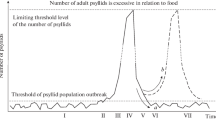Abstract
A sharp and prolonged change in developing population processes requires mathematical methods to be improved. Unusual phase changes in the development of mass reproduction of insect species stipulated the idea to develop a new model in which not the final form of an asymptotically stable state after bifurcations but transient modes are of importance. In concrete situations, it is proposed to consider the phenomena, which are identified with population outbreaks (non-stationary heterogeneous processes) in environmental studies, within the context of a long oscillatory mode only as peaks of the phases of sharp nonharmonic oscillations. The proposed new dynamic model in the form of a differential equation describes a decreasing pseudoperiodic damping trajectory of sudden sharp oscillations that implement a non-bifurcation scenario of spontaneous completion for a particular variant of mass forest pest reproduction. Situations in two provinces of eastern Canada are considered as examples.
Similar content being viewed by others
References
A. I. Vorontsov, Forest Entomology [in Russian], Ecologia, Moscow (1995).
J. R. Blais, “Spruce budworm outbreaks in the lower St. Lawrence and Gaspe regions,” The Forestry Chronicle, Vol. 37, No. 3, 192–202 (1961).
A. Y. Perevaryukha, “Modeling abrupt changes in population dynamics with two threshold states,” Cybernetics and Systems Analysis, Vol. 52, No. 4, 623–630 (2016).
L. R. Clark, “The population dynamics of Cardiaspina albitextura (Psyllidae),” Australian Journal of Zoology, Vol. 12, No. 3, 362–380 (1964).
W. C. Allee and E. Bowen, “Studies in animal aggregations: Mass protection against colloidal silver among goldfishes,” Journal of Experimental Zoology, Vol. 61, No. 2, 185–207 (1932).
A. A. Hall, Ecology and Evolution of Cardiaspina Psyllids, Their Bacterial Endosymbionts and Parasitoid Wasps, Thesis Submitted in Fulfilment of the Requirements for the Degree of Doctor of Philosophy, Western Sydney University (2016).
J. Berry, “Brown lace lerp hyperparasitoid found in New Zealand,” Biosecurity New Zealand, Iss. 68, 18–20 (2006).
B. Cooke, S. V. Neali, and J. Regniere, “Insect defoliators as periodic disturbances in northern forest ecosystems,” in: Plant Disturbance Ecology: The Process and the Response, Elsevier, Burlington (2007), pp. 487–525.
T. Royama, “Population dynamics of the spruce budworm,” Choristoneura Fumiferana, Ecological Monographs, Vol. 54, No. 4, 429–462 (1984).
ESTR Secretariat Atlantic Maritime Ecozone evidence for key findings summary. Canadian biodiversity: Ecosystem status and trends 2010. Evidence for Key Findings Summary Report 2014. No. 3. Ottawa, ON: Canadian Councils of Resource Ministers.
M. R. Rose and R. Harmsen, “Ecological outbreak dynamics and the cusp catastrophe,” Acta Biotheoretica, Vol. 30, 229–253 (1981).
T. Poston and I. Stewart, Catastrophe Theory and Its Applications, Pitman Publishing Limited, London (1978).
D. R. Brillinger, “The Nicholson blowfly experiments: Some history and EDA,” Journal of Time Series Analysis, Vol. 33, Iss. 5, 718–723 (2012).
G. Hutchinson, “Circular causal systems in ecology,” Annals of the New York Academy of Sciences, Vol. 50, Iss. 4, 221–246 (1948).
B. D. Hassard, N. D. Kazarinoff, and Y.-H. Wan, Theory and Applications of Hopf Bifurcation, Cambridge University Press, Cambridge (1981).
S. A. Gourley, J. W. So, and J. H. Wu, “Nonlocality of reaction-diffusion equations induced by delay: Biological modeling and nonlinear dynamics,” Journal of Mathematical Sciences, Vol. 124, Iss. 4, 5119–5153 (2004).
K. Gopalsamy, M. Kulenovic, and G. Ladas, “Time lags in a ”food-limited “population model”, Applicable Analysis, Vol 31, Iss. 3, 225–237 (1988).
J. Milnor, “On the concept of attractor: Correction and remarks,” Comm. Math. Phys., Vol. 102, No. 3, 517–519 (1985).
D. Ludwig, D. D. Jones, and C. S. Holling, “Qualitative analysis of insect outbreak systems: The spruce budworm and forest,” Journal of Animal Ecology, Vol. 47, No. 1, 315–332 (1978).
Author information
Authors and Affiliations
Corresponding author
Additional information
Translated from Kibernetika i Sistemnyi Analiz, No. 1, January–February, 2019, pp. 164–177.
*This work was performed within the projects No. 18-04-00399 (VIZR) and No. 17-07-00125 (SPIIRAN) of the Russian Foundation for Basic Research.
Rights and permissions
About this article
Cite this article
Perevaryukha, A.Y. Continuous Model for the Devastating Oscillation Dynamics of Local Forest Pest Populations in Canada*. Cybern Syst Anal 55, 141–152 (2019). https://doi.org/10.1007/s10559-019-00119-6
Received:
Published:
Issue Date:
DOI: https://doi.org/10.1007/s10559-019-00119-6



